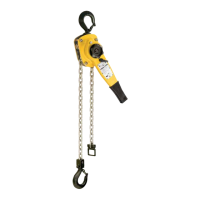3
English
INTRODUCTION
All users must read these operating
instructions carefully prior to the initial
operation. These instructions are intended to
acquaint the userwiththe product and enable
him to use it to the full extent of its intended
capabilities. Theoperating instructions contain
important information on how to handle the
product in a safe, correct and economic way.
Acting in accordance with these instructions
helps to avoiddangers, reducerepair cost and
down time and to increase the reliability and
lifetime of the product. Apart from the
operating instructions and the accident
prevention act valid for the respective country
and area where the product is used, also the
commonly accepted regulations for safe and
professionalworkmustbe adheredto.
CORRECTOPERATION
- The unit is used for lifting, pulling and ten-
sioningof loads.
- Theunitcanalsobe usedforlashingof loads
on trucks etc. please refer to the values for
hand and tensioning force “S” mentioned
on the nameplate.
- Thecapacityindicated on theproduct is the
maximumsafeworkingload(WLL)that may
be attached.
- The load and suspension hook of the hoist
during lifting operations, must be perpendi-
cular to the center of the load to prevent
pendlemotionof theload(Fig. 1).
- Do not allow personnel to passunder asus-
pended load.
GB
- After lifting or tensioning, a load must not
be leftunattendedforalongerperiodof time.
- Start moving the load only after it has been
attachedcorrectlyand allpersonnelareclear
of thedanger zone.
- The operator must ensure that the load is
attached in a manner that does not expose
himself or other personnel to danger by the
hoist,chain(s)or the load.
- The hoists can be operated in ambient tem-
peratures between -10 C and + 50 C.
Consult the manufacturer in case ofextreme
workingconditions.
Note: At ambient temperatures below 0 C
the brake should be checked forfreezing.
- The accident prevention act and/or safety
regulationsof therespectivecountryforusing
manualhoistsmustbe strictly adheredto.
- lf defects are found stop using the hoist
immediately.
INCORRECT OPERATION
- Do not exceedthe ratedcapacityof thehoist.
- Do not extendthe hand lever(Fig. 2).
- Weldingon hookandloadchainis strictlyfor-
bidden. The load chain must never be used
as groundconnectionduringwelding(Fig.3).
- Avoidsidepull,i. e.sideloadon eitherhous-
ingor bottom block(Fig. 4).
- It is forbidden to use this product for the
transportationof people(Fig.5).
- Theloadchainmustnotbe usedfor lashing
purposes(slingchain)(Fig.6).
- Do not knot or shorten the load chain by
using bolts/screws/screwdrivers or other
devices (Fig. 7). Do not repair load chains
installedin the hoist.
- Do not remove the safety latch from the top
or bottom hooks.
- Neverattach the loadon the tipof thehook.
Thisalsoappliesto the top hook (Fig. 8).
- Do not usethe chain stopas an operational
limitdevice(Fig.11).
- Turning of loads under normal operating
conditions is not allowed, as the bottom
blocksof the hoists arenotdesignedfor this
purpose. If turning of loads is required as
standard, the bottom blocks haveto be pro-
vided with swivel hooks supported by axial
bearings. In case of queries consult the
manufacturer.
- Do notthrowthe hoistdown.Alwaysplaceit
properlyon the ground.
- The device may not be used in potentially
explosivezones(specialdesignson request).
INSPECTION PRIOR TO INITIAL
OPERATION
Each unit must be inspected prior to initial
operation by a competent person. Theinspec-
verschlungen ist. Bei zweistrangigen Geräten
kann es zu einer Verdrehung z.B. dann
kommen, wenn die Unterflasche umge-
schlagenwurde(Fig.9).
Bei Kettenersatz ist auf richtigen Kettenverlauf
zu achten (Fig. 10). Außerdem muss die
Kettenschweißnahtnachaußenzeigen.
FUNKTION /BETRIEB
Kettenfreischaltung
Schalthebel (Fig. 11) in Neutralstellung
bringen. Die Kette kann in beide Richtungen
gezogen und der Lastkettenstrang schnell auf
Vorspannunggebrachtwerden.
Achtung: Die Mindestbelastung für das
automatische Schließen der Bremse liegt
zwischenmin.30 -45 kg.
Heben der Last
Schalthebel in Richtung Heben ‚ ‘ stellen und
einrastenlassen(Fig.11).
Mit Handhebel Pumpbewegungenausführen.
Wenn das Hebezeug unter Last steht, ohne
dass damit gearbeitet wird, muss der Schalt-
hebelin StellungHeben‚ ‘ verbleiben.
Die Last stets in der Hakenmitte einhängen.
Hakenspitzenichtbelasten(Fig.8).
Senken der Last
Schalthebel in Richtung Senken ‚ ‘ stellen und
einrasten lassen (Fig. 11).
Mit Handhebel Pumpbewegungenausführen.
Verspannungder Bremse
Wirdeinunter LaststehendesHebezeugdurch
Abheben der Last bzw. Einreißarbeiten plötz-
lich entlastet, ohne das zuvor die Senkarbeit
eingeleitet wurde, so bleibt die Bremse ge-
schlossen. Ein Schließen der Bremse erfolgt
ebenfalls, wenn der Lasthaken mit der Unter-
flasche zu fest gegen das Gehäuse gezogen
wird.
Lösen der verspannten Bremse
Schalthebel in Richtung Senken , ‘ stellen und
Handhebel ruckartig durchdrücken. Falls die
Verspannung sehr hoch ist, kann die Bremse
mit einer schlagartigen Belastung auf den
Handhebel gelöstwerden.
PRÜ FUNG/WARTUNG
Die Prüfung ist mindestens einmal jährlich,
bei schweren Einsatzbedingungen in kürzeren
Abständen, durch einen Sachkundigen
vorzunehmen. Die Prüfungen sind im
Wesentlichen Sicht- und Funktionsprüfungen,
wobei der Zustand von Bauteilen hinsichtlich
Beschädigung, Verschleiß, Korrosion oder
sonstigen Veränderungen beurteilt sowie die
Vollständigkeit und Wirksamkeit der
Sicherheitseinrichtungen festgestellt werden
muss.
Reparaturen dürfen nur von Fachwerk-
stätten, die Orginal YALE Ersatzteile
verwenden, durchgeführt werden.
Die Prüfungen sind vom Betreiber zu
veranlassen.

